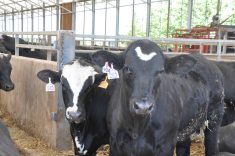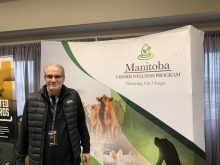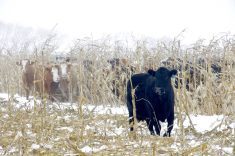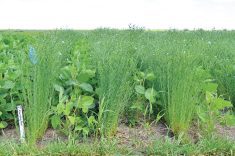The federal government and province have added to their S-CAP (Sustainable Canadian Agricultural Partnership) program announcements.
Several were made days before a 60-day pre-election provincial media blackout, which came into effect Aug. 4.
Announcements confirmed funding levels for the Resilient Agricultural Landscape Program (RALP). The two levels of government have approved more than $1.9 million for 54 projects under the program, according to a July 31 release.
Read Also

Journal pulls long-cited glyphosate study for ethics violations
The journal Regulatory Toxicology and Pharmacology has retracted a 2000 Monsanto-linked glyphosate review, drawing new scrutiny as Bayer faces mounting legal pressure.
“Manitoba farmers know that the success of their business depends on good stewardship of the land,” Manitoba Agriculture Minister Derek Johnson said. “We are proud to support them as they work to maintain and restore grasslands and wetlands on agricultural lands. This work isn’t just beneficial to the farmers; it contributes to the environmental and economic benefit to all Manitobans.”
RALP covers two funding streams. The Carbon Sequestration and Grassland Resilience program was flagged for particular interest by the livestock sector, with a mandate “to support on-farm projects that increase the productivity of grasslands that support a strong and viable livestock industry in Manitoba,” the July release read.
The project slated up to $15,000 per project. Projects have 18 months to be completed and the program will foot 75 per cent of the bill for eligible costs.
The federal and provincial governments tagged the stream for community pastures, Crown land forage leaseholders, Indigenous communities and farmers outside of watershed district boundaries.
The Watershed Resilience stream will provide up to $100,000 per approved project to selected watershed districts, also assuming the project could be complete within 18 months. The districts are meant to partner with specific farmers to implement projects to enhance natural and riparian areas, adopt new grazing management, allow water retention, bolster runoff management or restore/enhance wetlands.
Up to 100 per cent of eligible costs will be covered under the stream.
“Watershed districts are committed to educating communities on the importance of land management and supporting landowners to implement projects that protect and enhance their local landscapes,” Manitoba Association of Watersheds chair Garry Wasylowski said, adding his organization is “pleased to work with the province to support the districts in their efforts.”
Successful projects were gauged on their “ability to increase the environmental resilience of agricultural landscapes,” with a specific eye to bolstering soil and water quality, limiting greenhouse gas emissions, maintaining stream banks, improving water and nutrient retention or boosting wildlife habitat and biodiversity, according to the July 31 release.
Indigenous agriculture
The following day, another S-CAP announcement launched funding to support Indigenous agriculture and agribusiness and address barriers that block Indigenous peoples from participating in the industry.
“Ensuring Indigenous communities and organizations are equipped with the agricultural knowledge, skills and technology to increase their participation in the agricultural economy is critical,” said federal Agriculture and Agri-Food Minister Lawrence MacAulay. “We recognize that Indigenous communities have diverse and unique realities and the flexibility of the programs announced today reflect that diversity.
“Fostering relationships and working in partnership with Indigenous Peoples will support inclusive growth of the agri-food sector and contribute to economic reconciliation.”
The announcement included two streams: Indigenous Agriculture and Food Systems, focused on food security and sovereignty in Indigenous communities; and Relationship Development and Engagement, focused on linking Indigenous peoples with industry and research to foster opportunities.
The first of those streams will incorporate traditional food systems, the two governments said. “Culturally relevant services and the development of resource materials” are eligible for up to $80,000 under the program.
Past that, training initiatives designed to share skills and transfer knowledge could get up to $10,000. Up to $50,000 is available for capital equipment and software to implement or scale up agricultural activities or agri-food ventures (with project costs split evenly between the applicant and the program). Another category under the stream slates up to $200,000 for projects meant to develop and implement community-based food systems.
The second stream, meanwhile, will provide $5,000 grants to “support meaningful engagement activities prior to exploring ideas and initiating projects,” an Aug. 1 release read.
Manitoba Métis Federation Agriculture Minister David Beaudin said the announcement represents new opportunity for his organization and Red River Métis businesses and farmers.
However, the federation has concerns with the province’s definition of Indigenous. Applicants must only self-identify as Indigenous under current programming, “provided the activities have a positive outcome for the province and Indigenous peoples living in Manitoba,” the group said in an emailed statement.
It said the program as written does not require the lead applicant to be Indigenous.
“It is essential that programs are developed with inclusive eligibility and consider a process in which Manitoba is able to verify if an applicant is, in fact, Indigenous, as this opportunity should ensure a primary and direct benefit to relationship development and engagement with Manitoba, and should support Red River Métis food security and sovereignty,” Beaudin said.
The federation says it is open to discussing possible improvements with the province.
Program intake is open until Oct. 27.
– With files from Geralyn Wichers
















